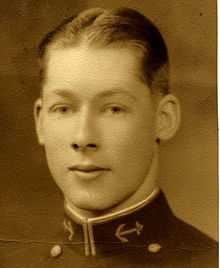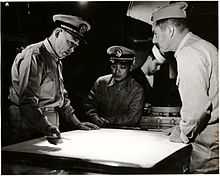Edwin B. Hooper
| Admiral Edwin Bickford Hooper | |
|---|---|
 Hooper pictured during World War II as a commander | |
| Born |
February 12, 1909 Winthrop, Massachusetts |
| Died |
September 26, 1986 (aged 77) Annapolis, Maryland |
| Buried at | United States Naval Academy Cemetery |
| Allegiance |
|
| Service/branch | United States Navy |
| Years of service | 1931-1976 |
| Rank | Vice Admiral |
| Battles/wars | |
| Awards | |
Edwin Bickford Hooper (Feb 26, 1909 - September 12, 1986) was a vice admiral of the United States Navy—his Naval service spanned 5 decades from 1930 to the 1970. He served in World War II, Korean and Vietnam Wars and made important contributions to gunnery, ship operations, ordnance, amphibious operations, military logistics and study of naval history. He directed the gunfire in an important battleship-against-battleship action in 1942; was involved in the early days of United States Atomic Energy Commission; established the Navy's long range study group; lead the Service Force during the Vietnam war; and was the Navy's Historian—writing several Navy histories including the first volume on the Vietnam War.
Early Life and Naval Career

Hooper was born in Winthrop MA in a house across the street from the Winthrop Yacht Club, where his father owned a Yawl. His parents were Fred A. Hooper and Flora Foster. He attended Huntington High School and the United States Naval Academy from 1927 to 1931.[1]
Hooper served on USS Pensacola (CA-24) from 1931 to 1936.[1] In 1934, he married Elizabeth Withers Patrick,[1] daughter of Captain Bower Reynolds Patrick (a Navy Chaplain) and sister of G. S. Patrick.
From 1936 to 1938, Hooper served on the USS Cushing (DD-376).[1]
From 1939 to 1939, Hooper attended Naval Academy Post-Graduate School and took a newly established fire control ordnance course.[1] In 1940, He attended the Massachusetts Institute of Technology, studied servo-mechanisms and received a Masters in Engineering.[1] Students in his class included three important naval officers: Alfred G. Ward, Horacio Rivero, Jr. and Lloyd Mustin.[2]
World War II -- Gunnery
In 1941, Hooper served on the USS Washington (BB-56) developing and improving fire control techniques to aim the gunfire of the 16 inch and 5 inch guns.[1][3][4] During the night action off Guadalcanal (14 November 1942 - 15 November 1942) (Guadalcanal Campaign ), Hooper served as Assistant Gunnery Officer and directed the fire of 16” and 5” guns.[1][3][4] The USS Washington sank the Japanese battleship Kirishima, using primarily 16” gunfire, and simultaneously engaged the Japanese cruiser Atago, using 5” gunfire. The Atego was damaged and returned to Japan for repairs. In the months before the battle, Hooper had uncovered and corrected small systematic errors in the fire control of the 16 inch guns and, as a result, very accurate Naval gunfire lead to the rapid sinking of the Kirishima. Hooper was awarded the Bronze Star for the Guadalcanal Battle, was promoted and made Gunnery Officer on the USS Washington – the most junior U. S. officer to hold that position in World War II.[1]
In 1944, Hooper served as Gunnery Officer on the USS Alaska (CB-1).[1] In 1945 while on the USS Alaska, Hooper suffered a series of heart attacks [1] and, after his recovery, became Officer in charge of ordnance, maintenance, and improvement on the staff of Commander, Service Force, United States Pacific Fleet.[1]
Atomic Energy Commission, Underway Replenishment, and Ordnance (Nuclear)
From 1947 to 1949, Hooper was assigned to the Military Applications Group of the United States Atomic Energy Commission.[1] He was involved in gaining approval for the 1948 Eniwetok tests (Operation Sandstone ) and attended one of the tests.[1]
From 1949 to 1950, Hooper was assigned as Captain of the USS Waccamaw(AO-19) a fleet oiler. As Captain, Hooper developed and tested techniques for resupplying ships in high seas and cold waters off Baffin Island and Greenland.[1]
From 1950 to 1952, Hooper was Assistant for Nuclear Applications in Bureau of Ordnance [1] and was responsible for developing the Mark 8 nuclear bomb and the Mark 90 nuclear bomb which could be flown on navy aircraft. In 1952 and 1953, Hooper attended the National War College.[1]
Korean War, Ordnance (Conventional) and Naval Studies
From 1953 to 1954, Hooper was Chief of Staff for the Destroyer Flotilla Three stationed in Japan.[1] The Flotilla had 78 destroyers; many of which were operating off Korea. The Flotilla was under the command of Rear Admiral Mendenhall. Since Mendenhall was involved in Korean armistice negotiations at Pan Mun Jom, Hooper operated the Flotilla on a day-to-day basis. From 1954 to 1955, Hooper was captain of the a destroyer tender USS Sierra (AD-18).[1]
From 1955-1958, Hooper was assigned to Bureau of Ordnance for Research as Assistant Chief.[1] Hooper guided the development of ASROC, an anti-submarine missile system, and the Mark 37 Torpedo. Hooper gained approval for the development of the AIM-9 Sidewinder.
From 1958-1959, Hooper was Commander of Destroyer Squadron 26 which was stationed in Norfolk VA [1] and, from 1959 to 1961, was first Director of the Institute of Naval Studies in Newport RI.[1][5] This institute conducted studies into long-range operations and goals of the U. S. Navy.
Vietnam War – Amphibious Operations and Logistics

From 1961 to 1962, Hooper was the Commander of Amphibious Group One in the Pacific [1] and a key member of the staff was Phil H. Bucklew. Initially, the command was located in Coronado CA and, during this period, a training Exercise Seawall in Washington State was conducted the Army's 4th Division. In 1962, the command was transferred to Subic Bay PI and Hooper was Operational Commander of the SEATO Exercise Tulungan. Tulungan involved landing U. S. Marines and Philippine Army units into Mindanao PI and was, in many ways, a final training exercise before the Vietnam War. The military commanders ( Rear Admiral Miller,[6] Lieutenant General Simpson,[7] Vice Admiral Blackburn,[8] and General Robert E. Cushman, Jr. ) and some of the troops were later involved in the war. During the exercise, troops were landed by boat, aircraft and helicopter – testing techniques used in the Vietnam War. During 1962, there was a low level conflict in New Guinea between the Dutch and Indonesia and the amphibious group wrote contingency plans to support evacuations.
From 1962 to 1965, Hooper worked in the Office of the Naval Operations in research and development.[1] Hooper was part of the team that negotiated the establishment of the Atlantic Undersea Test and Evaluation Center (AUTEC).
In 1965, Hooper became Commander of the Service Force for the Pacific ComServPac.[1] As the principal logistics agent for the Commander in Chief, U.S. Pacific Fleet, Hooper commanded over 56,000 Navy personnel who manned more than 128 ships, 22,000 non-military personnel, 14 overseas shore activities including Naval Support Activity, Saigon and numerous other mobile support units and staffs of the Pacific Service Force. The command had 78 types of ships – underway replenishment ships, repair ships, salvage ships, survey ships, hospital ships, and icebreakers. Hooper help establish and operate the major logistical bases in Danang, Chu Lai, and Camrahn Bay that supported both Army and Marine forces in Vietnam. The USS Pueblo AGER-2, when it was captured, was nominally under the command of the Service Force.[1]
Navy's Historian and Last Years
In 1968, Hooper returned to Washington DC, worked in the Office of Naval Operations,[1] and then as a Senior Member of the Joint Logistics Review Board, which studied logistics in the Vietnam War.[1] During this time he was promoted to Vice Admiral. In 1970, Hooper retired from active Navy duty and returned on limited duty as the Navy's Historian.[1] Hooper co-authored the first volume of the Navy's history of the Vietnam War. When Hooper finally retired in 1976,[9] Admiral Hyman G. Rickover sent Hooper a letter, which stated that “One of the most worthwhile aspects of my duty in Washington has been know a man as intelligent, kind, sincere, competent, and helpful as you.”[10] After retiring, Hooper wrote a book on the use of Naval Power,[11] which was published after his death in 1986. Hooper is buried at the Naval Academy Cemetery [12] and a small scholarship fund was established in his name.[13]
References
- ↑ 1.0 1.1 1.2 1.3 1.4 1.5 1.6 1.7 1.8 1.9 1.10 1.11 1.12 1.13 1.14 1.15 1.16 1.17 1.18 1.19 1.20 1.21 1.22 1.23 1.24 1.25 1.26 1.27 1.28 Hooper, Edwin (1978). The Reminiscence of Vice Admiral Edwin B. Hooper U. S. Navy (Retired). Annapolis, Maryland: U. S. Naval Institute. p. 1.
- ↑ "Mustin family". Retrieved 11 January 2014.
- ↑ 3.0 3.1 Hornfischer, James (2011). Neptune's Inferno: the U. S. Navy at Guadalcanal. Batnam Books. pp. 127, 348.
- ↑ 4.0 4.1 Musicant, Ivan (1986). Battleship at War: The epic story of the USS Washington. Harcourt Brace Javonovich. pp. Musicant, pp.13, pp.48.
- ↑ Tidman, Keith R (1984). The Operational Evaluation Group. Annapolis: United States Naval Institute. pp. 195–196.
- ↑ "Papers of Rear Admiral Henry L. Miller, 1942-1971". Retrieved 11 January 2014.
- ↑ "Lieutenant General Ormond R. Simpson, USMC". Retrieved 11 January 2014.
- ↑ "Paul P. Blackburn Jr.; Led 7th Fleet During Vietnam War". Retrieved 11 January 2014.
- ↑ Hooper, Edwin. The United States Navy and the Vietnam Conflict: Volume 1. United States Government Printing Office.
- ↑ Hooper, Edwin (1942–1986). Edwin Bickford Hooper papers. Manuscript Division, Library of Congress, Washington, D.C.
- ↑ Hooper, Edwin (1988). United States Naval Power in a Changing World. Praeger.
- ↑ "Adm Edwin Bickford Hooper". Retrieved 11 January 2014.
- ↑ "The Vice Admiral Edwin B. Hooper Research Grant". Retrieved 11 January 2014.